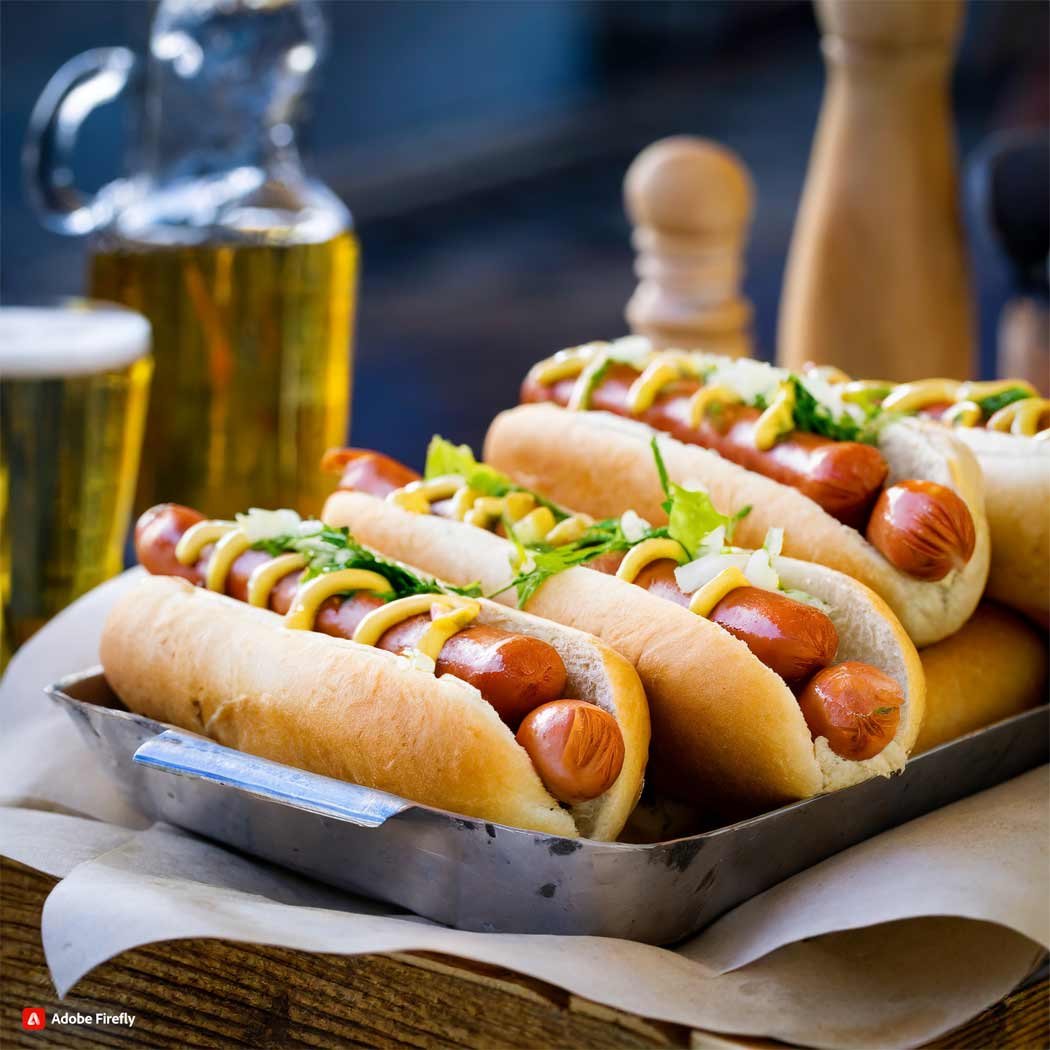The History of European Hot Dogs: From Bratwurst to Currywurst
Hot dogs are a beloved food all around the world, but did you know that the hot dogs we know and love today have their roots in Europe? The history of European hot dogs is a fascinating one, filled with unique flavors and cultural influences. From the traditional bratwurst to the popular currywurst, European hot dogs have a rich history that is worth exploring.

The origins of hot dogs can be traced back to Germany, where the first sausages were made in the 13th century. These sausages were made from a mixture of pork, beef, and spices, and were often served at festivals and markets. However, it wasn’t until the 19th century that the modern hot dog as we know it was born.
In 1852, a German immigrant named Charles Feltman opened the first hot dog stand in Coney Island, New York. He sold sausages in a bun, and this quickly became a popular street food. The hot dog’s popularity continued to grow, and it wasn’t long before it made its way back to Europe. You can read 90 Global Hot Dog Recipes.
In Germany, the bratwurst was the most popular type of sausage used in hot dogs. This sausage is made from pork and veal, and is seasoned with spices such as nutmeg, ginger, and coriander. It is traditionally served with sauerkraut and mustard, and is a staple at Oktoberfest celebrations.

In neighboring Austria, the hot dog took on a slightly different form. The Wiener Würstchen, also known as the Vienna sausage, is a thin and long sausage made from pork and beef. It is often served with ketchup and mustard, and is a popular street food in Vienna.
As hot dogs continued to gain popularity, they also started to evolve and take on new flavors. In the 1920s, a new type of hot dog emerged in Germany – the currywurst. This hot dog is made from a bratwurst that is sliced and served with a curry ketchup sauce. It quickly became a favorite among locals and tourists alike, and is now considered a quintessential German street food.
In the 1950s, the hot dog made its way to Denmark, where it was given a unique twist. The Danish hot dog, also known as the “pølse,” is made from a mixture of pork and beef, and is served in a bun with a variety of toppings such as remoulade, ketchup, mustard, and fried onions. It is often enjoyed as a late-night snack after a night out.
In the United Kingdom, the hot dog is known as the “Frankfurter,” and is often served with a variety of toppings such as onions, relish, and cheese. It is a popular street food and can be found at many sporting events and festivals. Read Lunch for Weight Loss.
In recent years, hot dogs have also become popular in Eastern Europe. In Poland, the kielbasa is a popular type of sausage used in hot dogs. It is made from pork and is often served with sauerkraut and mustard. In Hungary, the hot dog is known as the “kolbász,” and is made from a mixture of pork and beef. It is often served with a spicy paprika sauce and is a favorite among locals.
European hot dogs have come a long way since their humble beginnings in Germany. From the traditional bratwurst to the unique flavors of the currywurst and pølse, each country has put its own twist on this beloved street food. Whether you prefer your hot dog with sauerkraut, curry ketchup, or spicy paprika sauce, there is no denying the rich history and diverse flavors of European hot dogs. So the next time you bite into a hot dog, take a moment to savor the unique flavors and cultural influences that have made it the beloved food it is today.
Exploring the Diverse Toppings and Condiments of European Hot Dogs
Hot dogs are a beloved food all around the world, and Europe is no exception. However, what sets European hot dogs apart from their American counterparts is the diverse range of toppings and condiments that are used to enhance their flavor. From Germany to Spain, each country has its own unique twist on this classic dish, making it a must-try for any food lover.

In Germany, the hot dog, or “wurst” as it is known, is a staple street food. The most popular type of wurst is the bratwurst, a pork sausage that is grilled and served in a bun. But what truly sets German hot dogs apart is the variety of toppings and condiments that are used. One of the most popular toppings is sauerkraut, a fermented cabbage that adds a tangy and slightly sour flavor to the hot dog. Another popular topping is curry ketchup, a sweet and spicy sauce that is a favorite among locals. And for those who like a bit of heat, mustard is a must-have condiment for any German hot dog.
Moving on to France, the hot dog, or “hot-dog” as it is called, has a more gourmet twist. Instead of a traditional bun, the French use a baguette to hold their hot dogs. This gives the hot dog a crispy and flaky texture, elevating it to a whole new level. The toppings used in France are also unique, with the most popular being ratatouille, a vegetable stew made with eggplant, zucchini, and tomatoes. This adds a burst of flavor and freshness to the hot dog. Another popular topping is melted cheese, which is often used in combination with the ratatouille for a delicious and indulgent treat.
In Spain, the hot dog, or “perro caliente” as it is known, is a popular street food that is often enjoyed as a late-night snack. The most common type of hot dog in Spain is the “pancho,” a hot dog that is wrapped in bacon and grilled to perfection. The toppings used in Spain are simple yet flavorful, with the most popular being a garlic mayonnaise known as “alioli.” This creamy and garlicky sauce adds a unique twist to the hot dog, making it a must-try for any food lover. Another popular topping is “pimientos,” which are roasted red peppers that add a smoky and slightly sweet flavor to the hot dog.
Moving on to the Netherlands, the hot dog, or “hotdog” as it is called, is a popular snack that is often enjoyed at festivals and events. The most common type of hot dog in the Netherlands is the “frikandel,” a deep-fried sausage that is served in a bun. The toppings used in the Netherlands are a mix of sweet and savory, with the most popular being peanut sauce and chopped onions. This combination may sound unusual, but it is a match made in heaven, with the sweetness of the peanut sauce balancing out the sharpness of the onions.
Finally, in Poland, the hot dog, or “hot-dog” as it is known, is a popular street food that is often enjoyed with a cold beer. The most common type of hot dog in Poland is the “kielbasa,” a smoked sausage that is served in a bun. The toppings used in Poland are simple yet flavorful, with the most popular being pickles and sauerkraut. This combination adds a tangy and crunchy element to the hot dog, making it a favorite among locals.
In conclusion, European hot dogs may all have the same base of a sausage in a bun, but it is the toppings and condiments that truly make them unique. From tangy sauerkraut in Germany to creamy alioli in Spain, each country has its own twist on this classic dish. So the next time you’re in Europe, be sure to savor the diverse flavors of European hot dogs and experience a whole new world of deliciousness.
A Culinary Adventure: Trying Different Variations of European Hot Dogs Across the Continent
Hot dogs are a beloved food all around the world, and Europe is no exception. However, what many people may not know is that each country in Europe has its own unique twist on this classic dish. From Germany to Spain, hot dogs have been adapted and transformed to fit the local cuisine and culture. In this article, we will take you on a culinary adventure as we explore the different variations of European hot dogs across the continent.
We begin our journey in Germany, the birthplace of the hot dog. Here, the traditional hot dog, or “wurst” as it is known, is made with a pork and beef mixture and served in a long, crusty roll. But what sets German hot dogs apart is the variety of toppings and condiments that are used. From sauerkraut and mustard to curry ketchup and pickles, Germans take their hot dogs seriously and have perfected the art of topping them with a variety of flavors.

Moving on to neighboring Austria, we find the “Käsekrainer” hot dog. This unique variation is made with a pork and beef sausage that is filled with melted cheese. The sausage is then grilled and served with a side of mustard and bread. The combination of the savory sausage and gooey cheese makes for a delicious and indulgent treat.
As we make our way to France, we encounter the “hot dog à la française.” This version takes the traditional hot dog and elevates it with French ingredients and flavors. The sausage is made with a mixture of pork and veal and is served in a baguette instead of a bun. It is then topped with Dijon mustard, caramelized onions, and gruyere cheese. The result is a hot dog that is both elegant and delicious.
Next, we travel to Spain, where we find the “pancho.” This hot dog is made with a spicy chorizo sausage and is served in a soft bun. The toppings vary, but the most popular ones include a garlic mayonnaise called “alioli” and a spicy tomato sauce. The combination of the smoky chorizo and the tangy sauces makes for a hot dog that is bursting with flavor.
Our journey takes us to the Netherlands, where we discover the “frikandel.” This hot dog is made with a mixture of pork, chicken, and beef and is served in a soft bun. What sets the frikandel apart is the way it is cooked. Instead of grilling or boiling, it is deep-fried, giving it a crispy exterior and a juicy interior. It is then topped with a variety of sauces, including mayonnaise, ketchup, and curry ketchup.
Finally, we end our adventure in Denmark, where we find the “rød pølse.” This hot dog is made with a bright red sausage that is made with a combination of pork, beef, and spices. It is served in a soft bun and is topped with a variety of condiments, including ketchup, mustard, and remoulade, a tangy sauce made with pickles, mayonnaise, and curry. The rød pølse is a popular street food in Denmark and can be found at hot dog stands all over the country.
In conclusion, hot dogs may seem like a simple and universal food, but as we have seen, each country in Europe has its own unique twist on this classic dish. From the traditional wurst in Germany to the indulgent Käsekrainer in Austria, each variation offers a different and delicious experience. So the next time you find yourself in Europe, be sure to savor the unique flavors of European hot dogs and embark on your own culinary adventure.
Q&A
Q: What is Continental Twist?
A: Continental Twist is a food truck that specializes in serving unique European-style hot dogs.
Q: What types of hot dogs does Continental Twist offer?
A: Continental Twist offers a variety of hot dogs inspired by different European countries, such as the German bratwurst, the French merguez, and the Spanish chorizo.
Q: Where can I find Continental Twist?
A: Continental Twist is a food truck that can be found at various locations and events in the United States. You can check their website or social media pages for their current schedule.
Conclusion
In conclusion, Continental Twist offers a unique and delicious experience for hot dog lovers by bringing the flavors of Europe to their menu. With a variety of toppings and styles inspired by different European countries, customers can savor the distinct tastes of each culture in one convenient location. Whether you’re craving a classic German bratwurst or a French-inspired merguez sausage, Continental Twist has something for everyone to enjoy. So next time you’re in the mood for a hot dog, consider trying out this one-of-a-kind eatery and indulge in the flavors of Europe.
Please follow us on linkedin. You can learn all best canadian food recipes you can check our Culinary 1TouchFood Youtube and Telegram 1TouchFood page. Don’t forget Fighting Obesity Magazine and Radio Cooking.

